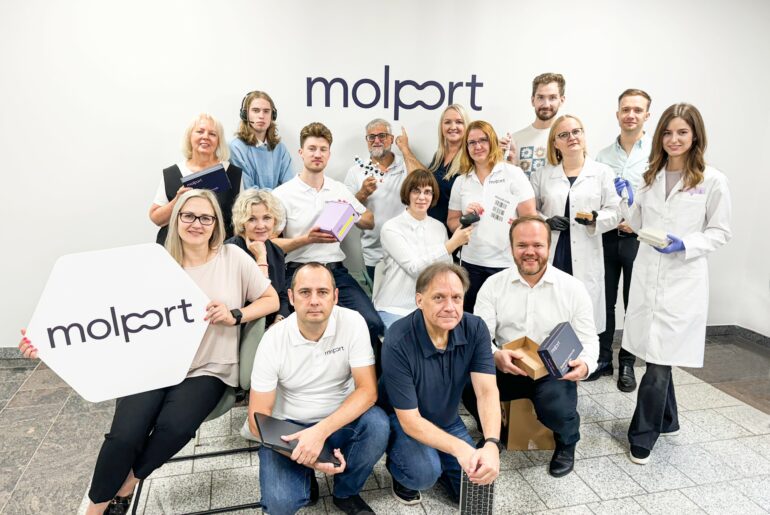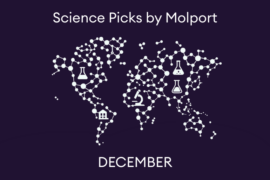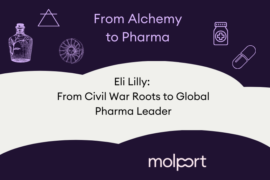We are very pleased to introduce you to our new CEO, Diana Zelencova-Gopejenko, Ph.D.
Here, we find out a little bit more about Diana, including her medicinal chemistry expertise and how she plans to use her first-hand experience of the whole drug development cycle to both expand Molport’s current offering and introduce new, tailored MedChem tools to make sourcing diverse chemical compounds from around the world easier and faster.
By enhancing access to chemical compounds and relieving the pressures on researchers with tools that she would have found invaluable as a researcher, Diana aims to ensure that Molport will be a key contributor to the acceleration of global drug discovery and development.
1. Please tell us about your background in medicinal chemistry and drug discovery
My background is in fact very similar to many of Molport’s customers. I initially studied chemistry and went on to work at the Latvian Institute of Organic Synthesis for 13 years. My PhD involved protein ligand binding studies and medicinal chemistry. Over the years, I’ve contributed to 15 scientific projects focused on drug design for treatment of various diseases, including cancer, cardiovascular disease, malaria, and Covid-19. These projects have resulted in a number of scientific papers in Q1 journals* as well as patents.
During my scientific career, I’ve worked across the whole early-stage drug development cycle, starting from computer aided drug design and continuing with experimental screening of both fragment libraries and drug-like compounds. Later, these results were used for hit-to-lead optimization, turning promising compounds into viable drug candidates.
I intend to leverage my experience and deep understanding of the entire drug development cycle to help Molport strengthen its support for our customers, making their research more efficient and shortening the path to clinical trials. Having worked in a smaller organization without huge internal resources and computational power, and also in collaboration with pharmaceutical companies, I can really appreciate the needs of Molport’s customers.
So, one of my aims is to enhance Molport’s role in the drug discovery process by expanding our quick and simple supply model for standard building block compounds and developing our offering of innovative solutions tailored to our customers’ needs. Everything can be possible for them, regardless of the size of their organization!
2. Why did you want to join Molport?
I’m excited to join Molport as it holds a unique position in the drug discovery world, and to myself.
Before joining Molport, I had the opportunity to experience its service excellence first-hand as a customer. What makes Molport truly special is its cutting-edge platform, bringing together chemical suppliers from around the world into one place at no extra cost – offering researchers access to an exceptionally diverse chemical space with a simple click.
I was particularly impressed by how user-friendly the platform is, allowing me to prepare tailored screening libraries and utilize cherry-picking options that perfectly fulfilled my research needs.
Molport’s innovative global marketplace and fantastic customer support really empowers researchers by offering fully customizable libraries of guaranteed quality. This is a real game-changer for those working in highly demanding fields such as drug discovery.
The ease and efficiency of working with Molport left a lasting impression on me. So, when invited to interview for the CEO position, I felt honored and excited about the potential to contribute to the company’s ongoing success. I’m incredibly grateful for the opportunity to now lead Molport and continue enhancing the company’s role in advancing global research efforts.
3. What is your vision for the future of Molport?
Over the past 17 years, Molport has been very successful in its aim to turn a complex, fragmented R&D chemical market into an easy-to-access, data-driven marketplace. I believe that the company has a strong foundation and great future prospects – to make things even bigger and better to efficiently serve customers all around the world.
My vision for Molport is to expand its role as a central player in the global drug discovery field by offering even more innovative and tailored solutions that help researchers accelerate their work. To better serve our customers, I see Molport continuing to simplify the process of sourcing chemical compounds, but also with a focus on customization.
We will enhance our platform to offer researchers even more customizable data sets, pre-filtered compound libraries, and MedChem tools. By doing this, we can provide comprehensive solutions that are highly specific to the unique needs of each research project.
We aim to relieve the pressure on researchers that have been dependent on their in-house capabilities. For example, Molport is actively working towards offering computational chemistry support in the near future. This will be a valuable resource for researchers who, like me in the past, relied heavily on in-house capabilities.
Additionally, we’ll improve our fast-delivery services for building blocks to ensure our customers can access critical materials quickly and efficiently to avoid delays in their research.
One of the biggest difficulties is the complexity and fragmentation of the global chemical market, which can slow down the drug discovery process. Molport is already addressing this by centralizing access to thousands of compounds, but I believe we can take this further by integrating more AI-driven tools to simplify and automate certain aspects of compound selection.
Overall, my goal is to position Molport as the go-to platform for all chemical sourcing needs, while continuously evolving to anticipate and meet the changing demands of the drug discovery community.
You mention AI-driven tools. Can you tell us a little more about your thoughts on these?
AI is of course a very hot topic in all aspects of our lives right now. An interesting recent development for the medicinal chemistry space is AlphaFold 3, a new AI model developed by Google DeepMind and Isomorphic Labs. It claims to have the power to accurately predict the structure and interactions of all of life’s molecules.
Integrating AI tools like AlphaFold 3 could help in predicting which small molecules make better drug candidates, and if they work, why not implement them? However, as with all AI, I think we need to be aware of its potential pros and cons, and investigate and trial it rigorously whilst remaining very cautious. It’s still very early days for AI, but it’s definitely on our radar!
4. What drew you into medicinal chemistry?
I think what first drew me to organic chemistry was my curiosity as to what and how things work! The concept of one molecule transitioning to other molecules and their synthesis fascinated me. Our bodies are always synthesizing or degrading something – that’s what seeded my interest in how drugs work. So, my work within the biochemistry group at the Latvian Institute of Organic Synthesis was hugely stimulating for me.
I’ve also always been motivated by the idea of making our world better, particularly by improving people’s well-being. This made medicinal chemistry an obvious path for me to pursue, as the development of new drug candidates can potentially lead to novel life-saving treatments.
I’m also deeply motivated by working with a talented team who are all passionate about their work. By combining our skills and knowledge, we can achieve shared goals and really push the boundaries in research for solutions for drug discovery.
5. What do you think are 3 key ingredients for success?
My 3 key ingredients for success are:
- Innovation and adaptability
- Customer focus
- Expertise
The drug discovery business and associated research changes fast, sometimes daily! New results can alter the direction and focus of a research project. So, Molport needs to adapt and provide more innovative solutions accordingly. For example, this might mean finding new suppliers who can reliably provide unique new chemistries.
It’s our customers who are driving the direction of the industry, so we must listen to them and respond to their feedback to be able to focus on and meet their research needs, both now and in the future. For this, strong customer relationships are essential.
And as such, to fully understand and support the industry, we must maintain a high level of expertise in chemistry and share our knowledge. Together, we can help drive better outcomes.
Ultimately, pursuing these key ingredients will enable Molport to constantly improve and adapt its services to ensure customer satisfaction, delivering tailored solutions and excellence in customer support.
6. Is there anything interesting about yourself that you’d like to share?
Well, the first thing that springs to mind is that I’m a black belt in Taekwondo!
I’m passionate about participating in sporting activities, which has in turn taught me discipline, focus, and resilience. This has helped me a lot in life, as I can stay calm when faced by many types of challenges, and kept me on track to achieve my goals
Perhaps also reflected from my love of sports is my strong drive for success, both in my professional and personal life. In all my scientific projects, I’ve always pushed boundaries, worked hard, and learned whatever was necessary to achieve results.
If I start something, I’m determined to finish it as best as I can. I think this persistence and focus resonates with Molport’s mission to support researchers in reaching their goals. And is something every individual in the company shares.
7. What can Molport’s customers expect from you personally in the future?
Molport’s customers can expect a high level of personal engagement from me directly. I believe that building strong, lasting relationships with our customers is essential for understanding their needs and ensuring we provide the best possible solutions.
I plan to actively meet with customers, in person, such as at scientific conferences, or virtually, to listen to their challenges and gain first-hand insight into the very latest research and how we can further improve our platform and services.
My focus will be on ensuring that Molport remains their first choice for compound sourcing by offering more than just a platform. We’ll offer a partnership.
I will prioritize maintaining a customer-focused approach, continually enhancing our services based on direct feedback and working closely with our team to deliver faster, more customized solutions.
I’m confident we can continue to push the boundaries of what Molport can offer, helping our customers accelerate their research and achieve success. Part of the reason for my confidence is because there is such a fantastic team at Molport. I’m so excited and inspired to be part of this enthusiastic team, where every person is an expert in what they do. Plus they all have great ideas for what can be done and improved for our customers in the future.
As I said, everything can be possible. And together, we can help drive better outcomes.
*A selection of key scientific publications involving Diana’s research
Kalnins G, Rudusa L, Bula A, Zelencova-Gopejenko D, Bobileva O, Sisovs M, Tars K, Jirgensons A, Jaudzems K, Bobrovs R. Structural basis for inhibition of the SARS-CoV-2 nsp16 by substrate-based dual site inhibitors. ChemMedChem. 2024, :e202400618. DOI: https://doi.org/10.1002/cmdc.202400618
Kalnins T, Vitkovska V, Kazak M, Zelencova-Gopejenko D, Ozola M, Narvaiss N, Makrecka-Kuka M, Domračeva I, Kinens A, Gukalova B, Konrad N, Aav R, Bonato F, Lucena-Agell D, Díaz JF, Liepinsh E, Suna E. Development of Potent Microtubule Targeting Agent by Structural Simplification of Natural Diazonamide. J. Med. Chem. 2024, 67(11), 9227-9259. DOI: https://doi.org/10.1021/acs.jmedchem.4c00388
Zelencova-Gopejenko D, Andrianov V, Domracheva I, Kanepe-Lapsa I, Milczarek M, Stojak M, Przyborowski K, Fedak FA, Walczak M, Kramkowski K, Wietrzyk J, Chlopicki S, Kalvins I. Aromatic sulphonamides of aziridine-2-carboxylic acid derivatives as novel PDIA1 and PDIA3 inhibitors. J Enzyme Inhib Med Chem. 2023, 38(1), 2158187. DOI: https://doi.org/10.1080/14756366.2022.2158187
Zelencova-Gopejenko D, Grandane A, Loza E, Lola D, Sipola A, Liepinsh E, Arsenyan P, Jaudzems K. Binding versus Enzymatic Processing of ε-Trimethyllysine Dioxygenase Substrate Analogues. ACS Med Chem Lett. 2022, 13(11), 1723-1729. DOI: https://doi.org/10.1021/acsmedchemlett.2c00261
Bobrovs R, Basens EE, Drunka L, Kanepe I, Matisone S, Velins KK, Andrianov V, Leitis G, Zelencova-Gopejenko D, Rasina D, Jirgensons A, Jaudzems K. Exploring Aspartic Protease Inhibitor Binding to Design Selective Antimalarials. J Chem Inf Model. 2022, 62(13), 3263-3273. DOI: https://doi.org/10.1021/acs.jcim.2c00422
Czarna A, Wang J, Zelencova D, Liu Y, Deng X, Choi HG, Zhang T, Zhou W, Chang JW, Kildalsen H, Seternes OM, Gray NS, Engh RA, Rothweiler U. Novel Scaffolds for Dual Specificity Tyrosine-Phosphorylation-Regulated Kinase (DYRK1A) Inhibitors. J Med Chem. 2018, 61(17), 7560-7572. DOI: https://doi.org/10.1021/acs.jmedchem.7b01847





